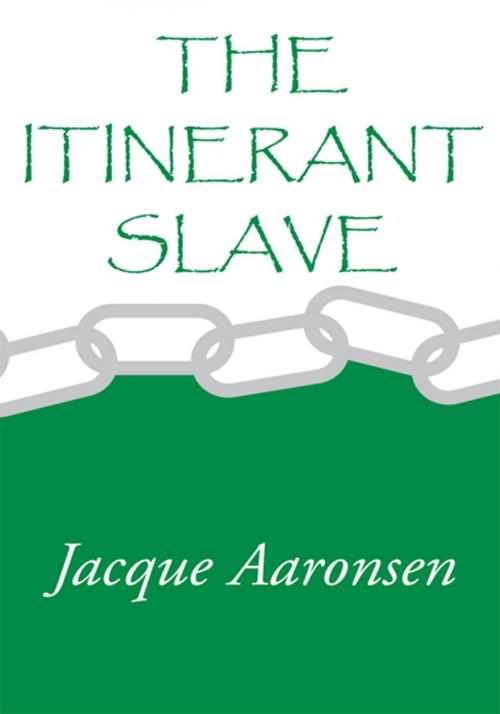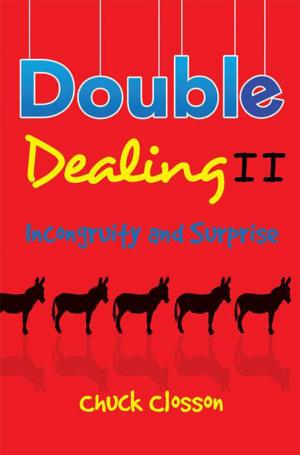| Author: | Jacque Aaronsen | ISBN: | 9781462800315 |
| Publisher: | Xlibris US | Publication: | April 10, 2001 |
| Imprint: | Xlibris US | Language: | English |
| Author: | Jacque Aaronsen |
| ISBN: | 9781462800315 |
| Publisher: | Xlibris US |
| Publication: | April 10, 2001 |
| Imprint: | Xlibris US |
| Language: | English |
BOOK DESCRIPTION
A handsome young school teacher from Chicago time-travels to Ancient Rome, Antebellum New Orleans, and 1940s Arabia to learn first hand what its really like in a slave society - and he turns out to be the slave! His handsome good looks and winsome personality find him first a near-naked litter-bearer, then a liveried groomsman, and finally a chauffeur - among other things! He returns to his Chicago classroom with tales no one will believe. Or doesnt want to!
A psychologist tackles the difficult question of how ordinary persons, suddenly thrown into conditions of abject slavery, can adjust to a reality where they are now possessions, not people. Slaves discover that bondage magnifies the value of even the simplest of lifes pleasures; that being denied expression doesnt stop thoughts and feelings; and experiencing social death doesnt deny their humanness. But survivors must learn to think very differently about themselves, their owners, and their society.
Sadly, one of the most recurring themes of human history is mans quest to subject and exploit others to his direct benefit. The extreme case of such exploitation, human slavery, goes back as long as recorded history and, for many parts of the world, was a predominant segment of society until only recently. How could such huge numbers of people allow themselves to be so completely exploited? How did they adjust to the realities of being totally subject to anothers will? And how did loss of freedom (or never experiencing freedom) alter the cognitive functioning of the enslaved, both at the time of enslavement and, for some, after being freed? Slaves themselves usually had no opportunity to record their reactions to enslavement (and were usually illiterate if such an opportunity were presented), but more importantly, slave societies were carefully constructed so that those in power were neither interested in the questions or any answers that might be forthcoming if the questions were asked. In fact, most slave societies viewed slaves as mere non-thinking animals who happened to conveniently possess limited ability in verbal communication and who were so brutish that they had limited, if any, human feelings.
In The Itinerant Slave, the author, a developmental psychologist, explores slavery from a slaves viewpoint with special emphasis on probable psychological reactions to the initial loss of freedom, adjustment to a life totally controlled by others with the minimum amount of pain, and the psychological reformulation necessary to survive somewhat intact. Its fiction, but the reader cannot help but identify with the plight of the novels hero as he copes with enslavement in three very different historical slave societies.
For most Americans, slavery was a racial exploitation unique to the South and ending with the Civil War. For the rest of the world, slavery was a fact of life from pre-recorded history, had nothing to do with the color of ones skin, involved huge segments of the population, and extended itself well into the twentieth century. Indeed, slavery still exists in certain areas of the world (e.g. Mauritania, the Sudan, etc.), albeit in slightly different forms (e.g. contract labor, coerced prostitution, prison labor, etc.).
In an effort to challenge the way we see the institution of slavery and especially how we judge those enslaved, "The Itinerant Slave" was written as a psychological historical adventure/time-travel novel which goes back in time rather than forward. The book describes the adventures of a young, handsome, bright, and articulate high school teacher from Chicago who time-travels into three distinctly different historical slave societies: Ancient Rome, the American Antebellum South, and Arabia in the 1940s. In each society, he falls into the hands of slavers, has to deal with the expectations imposed on slaves inherent in those particular societies, and eventually finds
BOOK DESCRIPTION
A handsome young school teacher from Chicago time-travels to Ancient Rome, Antebellum New Orleans, and 1940s Arabia to learn first hand what its really like in a slave society - and he turns out to be the slave! His handsome good looks and winsome personality find him first a near-naked litter-bearer, then a liveried groomsman, and finally a chauffeur - among other things! He returns to his Chicago classroom with tales no one will believe. Or doesnt want to!
A psychologist tackles the difficult question of how ordinary persons, suddenly thrown into conditions of abject slavery, can adjust to a reality where they are now possessions, not people. Slaves discover that bondage magnifies the value of even the simplest of lifes pleasures; that being denied expression doesnt stop thoughts and feelings; and experiencing social death doesnt deny their humanness. But survivors must learn to think very differently about themselves, their owners, and their society.
Sadly, one of the most recurring themes of human history is mans quest to subject and exploit others to his direct benefit. The extreme case of such exploitation, human slavery, goes back as long as recorded history and, for many parts of the world, was a predominant segment of society until only recently. How could such huge numbers of people allow themselves to be so completely exploited? How did they adjust to the realities of being totally subject to anothers will? And how did loss of freedom (or never experiencing freedom) alter the cognitive functioning of the enslaved, both at the time of enslavement and, for some, after being freed? Slaves themselves usually had no opportunity to record their reactions to enslavement (and were usually illiterate if such an opportunity were presented), but more importantly, slave societies were carefully constructed so that those in power were neither interested in the questions or any answers that might be forthcoming if the questions were asked. In fact, most slave societies viewed slaves as mere non-thinking animals who happened to conveniently possess limited ability in verbal communication and who were so brutish that they had limited, if any, human feelings.
In The Itinerant Slave, the author, a developmental psychologist, explores slavery from a slaves viewpoint with special emphasis on probable psychological reactions to the initial loss of freedom, adjustment to a life totally controlled by others with the minimum amount of pain, and the psychological reformulation necessary to survive somewhat intact. Its fiction, but the reader cannot help but identify with the plight of the novels hero as he copes with enslavement in three very different historical slave societies.
For most Americans, slavery was a racial exploitation unique to the South and ending with the Civil War. For the rest of the world, slavery was a fact of life from pre-recorded history, had nothing to do with the color of ones skin, involved huge segments of the population, and extended itself well into the twentieth century. Indeed, slavery still exists in certain areas of the world (e.g. Mauritania, the Sudan, etc.), albeit in slightly different forms (e.g. contract labor, coerced prostitution, prison labor, etc.).
In an effort to challenge the way we see the institution of slavery and especially how we judge those enslaved, "The Itinerant Slave" was written as a psychological historical adventure/time-travel novel which goes back in time rather than forward. The book describes the adventures of a young, handsome, bright, and articulate high school teacher from Chicago who time-travels into three distinctly different historical slave societies: Ancient Rome, the American Antebellum South, and Arabia in the 1940s. In each society, he falls into the hands of slavers, has to deal with the expectations imposed on slaves inherent in those particular societies, and eventually finds















